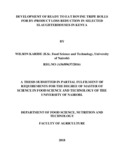| dc.description.abstract | Slaughterhouse by-products losses pose a notable challenge in Kenyan abattoirs at present. Slaughterhouse owners, meat traders, renderers and operators of meat facilities often lack preservation technologies and appropriate knowledge for incorporating by-products into regular commercial products. Adding value to meat by-products is one of the approaches that can be employed to reduce losses because the developed products can significantly raise the uptake of the by-products. Consequently, the income for operators could increase, food and nutrition security enhanced, the environment is conserved and the market gets a variety of products. Bovine tripe and other internal organs (offals) contribute to significant losses among other by-products in abattoirs. The information on how they are utilized by various communities and their commercial potential is very limited in spite of the advances in modern processing technologies in Kenya.
Bovine tripe was identified as one of the major by-products obtained after slaughter operations in Kenya. This study was hence designed to establish how bovine tripe is utilized by pastoral communities and peri-urban consumers in Kenya with the aim of potential commercialization. The study was carried out in the pastoral Counties of Marsabit, Turkana, Kajiado and Garissa and the Kiambu County bordering Nairobi County to represent the peri-urban area. Data were collected using focus group discussions, key informant interviews, semi-structured questionnaires and direct visual observations in selected slaughterhouses.
The results showed that the yield of bovine tripe based on live weight of cattle was 0.76-2.0% and it was mainly utilized as human food and pet food by most communities in the study regions. Some communities also discarded significant quantities of tripe due to traditions, culture and religious beliefs. Generally, tripe used for human consumption was prepared in different ways
such as stewing (36.36%), frying (81.81%), braising (54.54%) and broiling (72.72%). The study showed that tripe was not effectively utilized across all the counties resulting into huge post slaughter losses which differed significantly (P<0.05) among the study counties. Therefore, it was utilized in the development of commercial value added product in this study. Ready to eat bovine tripe rolls were formulated from a combination of rumen, reticulum, omasum and abomasum parts of tripe. Mechanical tenderization was used to improve the tenderness of the products which were then stored at 4±1◦C for 28 days in different packaging conditions. They were evaluated for physico-chemical and sensory characteristics at intervals of 7 days for 28 days. Significant changes (p<0.05) in sensory and physico- chemical characteristics were observed in minced, blade tenderized and control (non-tenderized) products during storage. The cooking losses (9.07%-12.09%) and shear force values (2.31N-4.43N) among the minced, blade tenderized and control products differed significantly (p<0.05) during storage. The average pH ranged from 6.4 to 6.0, Extract release volume (ERV) (22.2-17.9ml), Peroxide value (1.81-16.04 meq/kg), TBA (0.55-0.91mg malonaldehyde/kg) and tyrosine value (0.43-0.78 mg tyrosine /100g) among the products.
Sensory evaluation was conducted on days 0, 7 14, 21, 28 days of storage by lining up a panel of 32 untrained members who are familiar with meat products. The scores for all the samples under vacuum packaging were well within the acceptable limits up to 28 days of storage at 4±1 °C. However, all the samples stored aerobically were acceptable until 21 days of storage after which extremely high off odors due to increased lipid oxidation were observed which reduced their scores significantly (P<0.05).
The evaluation of the product for microbial quality was done using standard analytical methods at intervals of 7 days for 28 days under refrigeration conditions. The microbial counts results
showed that Listeria monocytogens, Campylobacter, Escherichia coli and Salmonella spp were all absent in both aerobic and vacuum packed. The detected bacterial counts were in the ranges specified for Ready to eat (RTE) meat products by Kenya bureau of Standards (KEBS) for the 28 days storage period of vacuum packaged products. However, the microbial counts in aerobically packaged products were significantly (p<0.05) higher than in vacuum packed products and slight off odours and slime appeared in some products on 28th day of storage. The highest days means counts for total viable counts, Clostridium perfringens, Staphylococcus aureus, yeast and molds, Psychrophilic counts and Lactobacillus spp were 5.4 log10 cfu/g, 1.7 log10 cfu/g, 1.9 log10 cfu/g, 4.1 log10 cfu/g, 5.2 log10 cfu/g, 2.1 log10 cfu/g respectively in both packages. The study revealed that acceptable tripe rolls can be developed from raw tripe. The study also concluded that vacuum packaging is extra effectual than aerobic packaging in inhibiting oxidation of lipids, microbial growth, protecting the organoleptic quality of the product as well as extending the shelf-life of the ready to eat bovine tripe rolls. There is also need to pursue other potential uses of bovine tripe to ensure no losses occur after slaughter. | en_US |



